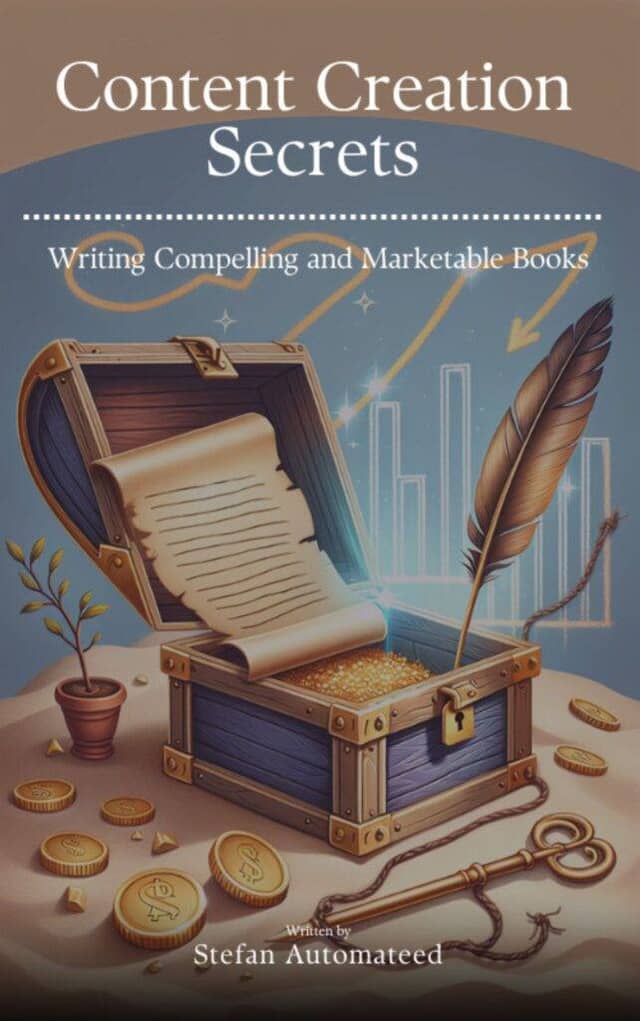Table of Contents
Creating an eBook (electronic book) that resonates with your audience involves more than just compiling information. It’s an art that combines design elements, content, and strategy. There are various types of eBooks—from interactive eBooks enriched with multimedia elements to straightforward guides—that can serve different purposes. Whether you’re looking to create your own eBooks to sell or to offer an ebook for free as part of your digital marketing strategy, understanding the key components is essential. Let’s delve deeper into each element to guide you in creating an eBook that not only looks great but also engages and retains reader interest. We’ll also look at some of the best eBook examples in PDF to inspire you.
Ebook Examples PDF
Here are some great eBook examples to inspire your creativity. These were all created by our ebook creator software – Automateed.com. And they are completely unedited. So, if you want to create your own ebooks, there is a free trial, and you can try it out—it takes less than 15 minutes. Using our software is an easier way to create professional eBooks, and it’s a great way to promote your brand or content. You’ll get a good ebook design (ready for Amazon KDP), and you’ll get a new ebook within minutes.
Click on the image to download the book.
10 Super Tips to Writing Amazing Books
- Know Your Target Audience: Before you start creating your eBook, figure out who you’re writing for. Understanding your target audience helps ensure that your eBook aligns with your brand’s message and serves as an effective marketing asset. This insight shapes your content, making it hit the right notes with your readers and ensuring your inbound marketing efforts resonate well.
- Use an eBook Template to Plan Your eBook: Utilize eBook templates to get started and sketch out your ideas before you begin writing. Outlining your main topics, subtopics, and key points helps ensure that your eBook’s design elements are well-organized. This planning stage is an easier way to create a coherent structure, making it easier for your readers to follow.
- Choose a Catchy Title and Cover Design: Your eBook’s title and cover are crucial design elements—the first things people see. Use appropriate font sizes and styles to make them eye-catching and reflective of what’s inside. A compelling title and an attractive cover design can significantly enhance your marketing content by drawing readers in and promising them value.
- Start with Something That Grabs Attention: Include an engaging opening in your eBook—an interesting fact, a provocative question, or a compelling story—that makes people want to read more. This is essential to creating an effective eBook that sets the tone and keeps your readers eager to see what’s next.
- Keep It Clear and Simple: Write in a straightforward way using appropriate font sizes and clear language. Short sentences work best, especially when people are reading on screens. Ensuring that your eBook is easy to read makes it more digestible and enjoyable for your audience.
- Add Visuals Like Charts and Infographics: Incorporate multimedia elements and design elements like charts, images, and infographics to make your eBook more interesting and break up text-heavy pages. These visuals explain ideas simply and keep your readers engaged.
- Make Your eBook Interactive: Transform your eBook into an interactive eBook by adding links to additional resources, internal navigation, or embedding multimedia elements like videos. Including these features in your eBook can turn it into an immersive experience, making it more engaging for your readers.
- Ensure It Looks Good on All Devices: People read eBooks on everything from Kindles to smartphones. Ensure that your eBook looks great in digital form across all devices by choosing a popular eBook format and responsive design that’s easy on the eyes.
- Edit and Proofread: Typos and grammar mistakes can detract from your eBook’s professionalism. Ensure that your eBook is polished by using editing tools or hiring a professional editor. A well-edited eBook builds trust and keeps your readers focused on your message.
- Learn the Basics of SEO: If you’re publishing your eBook online or on a publishing platform, understanding SEO is crucial. Incorporate relevant keywords in your title, description, and throughout your eBook to improve its visibility online. This digital marketing strategy can help you sell your ebook more effectively and gather valuable marketing analytics.
Creating an eBook is pretty cool because you can do almost everything with automated AI tools and ebook creators. This includes selecting snazzy design elements, writing your content, and even making your ebook interactive. It’s an easier way to create and a great way to promote your brand. However, there’s one thing AI can’t do for you: learning basic SEO. But don’t worry! SEO is mainly about choosing the right keywords for your ebook, especially if you’re planning to sell it on Amazon KDP or your own website. This helps more people find your book.
If you’re stuck on finding the right keywords, tools like ChatGPT can help you get started. Just ask it something like: “Hey, my topic is [your topic], and I need some keywords for Amazon KDP. Can you help?” And boom, you’re all set with keywords!
Remember, besides keywords, make sure your ebook looks good. Use a simple eBook template to get started, ensure that your ebook is easy to read with appropriate font sizes, and add some cool design elements. You can use tools like Adobe InDesign or Canva for this. It’s an easier way to create a professional-looking eBook. And don’t forget, your eBook cover matters a lot too!
Designing Your eBook Cover: How to Wow Your Readers
Pick a Killer Template
Finding the perfect eBook cover doesn’t have to be a chore. Jumpstart your design with free eBook templates to get started from sites like Canva or Adobe Spark. These platforms are gold mines for anyone looking to create an eBook that reflects your brand’s identity. With templates for every possible theme—from self-help to sci-fi—you can easily find one that resonates with your eBook’s vibe and the types of eBooks you’re creating. This step is essential in making your eBook stand out, ensuring it’s not just another drop in the ocean of free eBooks. Or you can simply use Automateed, and we’ll do it for you in Kindle ready-to-publish format.
Images That Tell Your Tale
Every popular eBook has a cover that tells a story at a glance. Whether it’s a chilling thriller or a cozy romance, the right image and design elements can make all the difference. Incorporating multimedia elements from Unsplash and Pixabay, which offer treasure troves of free, high-quality images, can elevate your marketing content. Selecting an image that complements your eBook’s content and theme can intrigue potential readers and is a crucial step in creating a visually appealing eBook that people want to download. Or you can use Automateed to create AI images that really stand out.
Color Me Curious
The color palette you choose for your eBook cover speaks volumes about your brand’s personality. Utilizing brand colors or selecting a palette that evokes the right emotions can significantly impact your eBook’s appeal. Tools like Coolors and Adobe Color are fantastic resources that can help you choose visually appealing design elements, ensuring that your eBook is easy on the eyes and grabs the reader’s attention. Remember, a great eBook design marries the right colors with your content, making your eBook not just readable but memorable.
Fonts That Talk
The font and font size on your eBook cover are crucial design elements that convey the voice of your title. It can whisper, shout, or sing the essence of your story. Google Fonts offers a wide selection of free fonts, allowing you to find the perfect typeface that matches the tone of your eBook. Whether it’s elegant script fonts for romance novels or strong, bold letters for a non-fiction guide, choosing the right font is crucial to ensure that your eBook stands out in a crowd of traditional books and eBooks alike.
Formatting Your eBook: Making It Easy for Every Reader
The Right Tools for the Job
When it comes to eBook creation and formatting, tools like Adobe InDesign are your best friends. It’s the industry standard for creating a layout that’s both visually appealing and responsive across all devices. Using the right tools to create your eBook makes the process easier and ensures that your eBook is professional and engaging. Whether you’re crafting long-form content or a quick guide, InDesign can help you create a professional-quality eBook without needing a design degree.
Keep Your Readers Engaged with Interactive Elements
Elevating your eBook from a simple read to an interactive eBook can make all the difference. Including multimedia elements such as quizzes, videos, or hyperlinks within your eBook can transform passive reading into an active experience. These features not only make the eBook more engaging but also provide additional value to your readers, making your eBook a resource they’ll want to come back to. Tools like Adobe InDesign facilitate adding these elements, ensuring your eBook is a step above the rest.
Layout Love
A clear table of contents and a well-organized layout are the backbones of a user-friendly eBook. Including appropriate font sizes, design elements, and breaking up your text with subheadings, bullet points, and images helps to keep your content digestible and engaging. Ensuring that your eBook is well-organized, regardless of its length, makes it accessible to everyone, from those sneaking in a read on their commute to those dedicatedly scrolling through on their tablets.
Make It Picture-Perfect
Incorporating high-quality images and multimedia elements is key to creating an eBook that’s visually compelling and enriching for the reader. Sites like Unsplash and Pixabay offer vast collections of free images that can elevate your content. Whether you’re illustrating complex ideas with simple infographics or adding flair with photos, these design elements play a crucial role in ensuring that your eBook is a great example of visual storytelling. They’re not just decorations; they’re integral parts of your eBook’s narrative.
Test Drive Your eBook
Before you hit the publish button, it’s critical to see how your eBook fares on different devices. Publishing platforms like Amazon Kindle Direct Publishing offer tools like Kindle Previewer, ensuring that your eBook is compatible and looks great across all Kindle devices. This step is about ensuring that your eBook is ready for distribution, whether you’re planning to sell your ebook or offer it for free. Choosing a popular eBook format like EPUB or MOBI helps in reaching a wider audience and ensures that your eBook provides the best possible experience across various devices.
Examples of Successful ebook Authors – Case Studies

1. “The Martian” by Andy Weir
- Background: Initially self-published on Andy Weir’s blog for free, one chapter at a time.
- Success Factors: Gained a cult following online, leading Weir to create a Kindle version, which sold 35,000 copies in three months.
- Outcome: Caught the attention of a literary agent, leading to a print deal and later adapted into a major motion picture.
2. “Fifty Shades of Grey” by E.L. James
- Background: Started as a “Twilight” fan fiction, later evolved into an original series.
- Success Factors: Gained popularity on fan fiction websites before being self-published as an eBook and print-on-demand.
- Outcome: Sold over 100 million copies worldwide, was translated into multiple languages, and adapted into a film series.
3. “Lean In” by Sheryl Sandberg
- Background: Written by Facebook COO Sheryl Sandberg, focusing on women in leadership.
- Success Factors: Leveraged Sandberg’s public profile and professional network. It sparked widespread media discussion and debates.
- Outcome: Became a bestseller, selling millions of copies. Inspired a global community group, “Lean In Circles.”
4. “On a Pale Horse” by Piers Anthony
- Background: A fantasy novel, first in the “Incarnations of Immortality” series.
- Success Factors: Unique blending of fantasy, science fiction, and modern elements. Strong online marketing and an established fan base.
- Outcome: Consistent sales over time, leading to a successful series with a dedicated following.
5. “Wool” by Hugh Howey
- Background: Started as a series of short stories self-published through Amazon’s Kindle Direct Publishing.
- Success Factors: Strong word-of-mouth, viral spread among sci-fi enthusiasts, and high-quality writing.
- Outcome: Landed a major print deal, sold film rights, and became a benchmark for self-publishing success in the digital age.
FAQ
What counts as an ebook?
An eBook, or electronic book, is a digital form of a book designed to be read on electronic devices like e-readers (Kindle), tablets, smartphones, and computers. It encompasses various types of ebooks, from novels and how-to guides to B2B ebook examples used in digital marketing. eBooks can be simple PDFs or interactive ebooks enriched with multimedia elements such as hyperlinks, videos, and interactive graphics. The flexibility in ebook creation and design allows for creative content beyond traditional printed books, making it a popular choice for authors and marketers alike.
What is the typical eBook format?
The most popular ebook formats include EPUB and MOBI, known for their reflowable content that adapts to different screen sizes and devices. PDFs are also common, especially for fixed-layout ebooks. When creating your ebook, using free ebook templates and paying attention to design elements like font size and layout per page ensures that your ebook is readable and visually appealing across various devices. These formats support a range of content, from text and images to multimedia features, making your ebook engaging and accessible.
Are ebooks profitable?
Yes, creating eBooks can be a highly profitable venture, especially when leveraged as a marketing asset in digital marketing strategies. You can sell your ebook through various marketing channels, including your own website, publishing platforms like Amazon KDP, or offer it for free as part of your inbound marketing efforts. According to the Content Marketing Institute, eBooks are one of the most effective tools for B2B marketers, often used to generate leads and educate customers. Promoting your ebook through persuasive landing pages and effective email marketing can significantly boost your sales and conversions. Effective promotion and distribution of your eBook can enhance profitability and expand your reach to potential customers.
How does an eBook work?
An eBook works by providing content in a digital format that can be read on electronic devices. They often utilize reflowable text, which adjusts to different screen sizes, and can include interactive elements like hyperlinks and multimedia. eBooks can be distributed through various publishing platforms and marketing channels, making them versatile tools for reaching a wide audience.
Wrapping It Up: Your eBook Adventure Awaits!
Let’s wrap this up and get you started on your eBook creation journey!
Picture this: Your eBook starts as a tiny idea—maybe a cool story, some awesome tips, or just stuff you love talking about. That little idea? It’s about to become a big deal eBook that folks everywhere could be reading.
Here’s what you’ve got to remember: Snag some tips from the pros, let those success stories help you get started, and just start creating. Creating your own ebooks is an easier way to promote your brand and share what you know. It’s a great way to connect with your audience and make an impact.
Don’t sweat about making it perfect. The real fun is in the journey—coming up with your story, picking out snazzy design elements, and bringing your eBook to life. And guess what? Making your eBook look amazing is a breeze with free eBook templates and cool tools like Adobe InDesign.
So, why not kick things off today? Your next ebook could be the next big thing that gets people talking. All you’ve got to do is begin. Hit publish with places like Amazon Kindle Direct Publishing, jazz up your eBook with neat templates, and pack it with everything from a spot-on table of contents to nifty interactive bits that make your eBook pop.
Happy writing, and here’s to the start of your very own eBook adventure!
So, hey, why not start today? Your eBook could be the next big thing that gets people talking. All you’ve got to do is begin. Here’s where you can start!
Happy writing, and here’s to the start of your very own eBook adventure!









